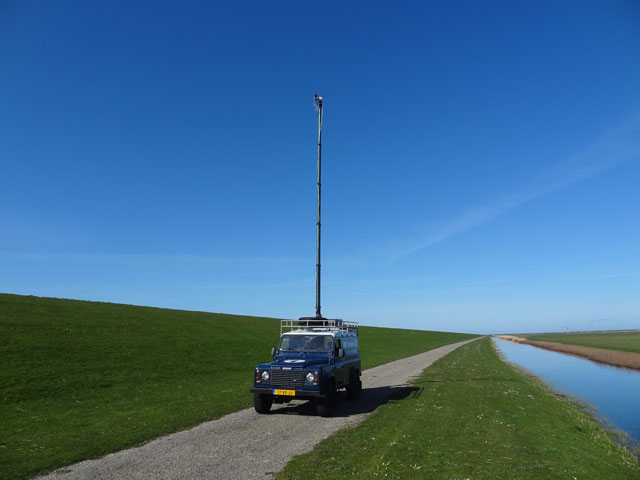The Netherlands has a strong reputation regarding to water safety. However, flood defence behaviour – under different circumstances – is still hard to forecast. So occasionally we choose to be on the safe side and carry out dike reinforcements that are probably unnecessarily severe sometimes. Fortunately our understanding of dike behaviour is increasing.
The Dutch water boards have been monitoring their flood defence for decades now. This is called Dike watching – observing the condition of the dike with nothing more than the bare expert eye. Subsequently this method was complimented with height measurements and water level measurements. Useful, but still often supplying too little information on water barrier and soil.
Based on objective measurements, a well-designed and gradually implemented monitoring programme can give a detailed impression of the vulnerable spots prior to the occurrence of one or more failure mechanisms in a flood defence.
For instance ‘from coarse to fine’ starting with a number of measurements carried out in repetition on a longer distance at the dike surface, followed by more detailed ‘point’ measurements inside of the dike, at those spots were the highest added value of these measurements can be expected. Some recent projects support this approach.
In the past few years an intensive dike-monitoring programme has been implemented at the Ommelandersea Dike in the province of Groningen (between Eemshaven and Delfzijl) carried out by the Foundation Floodcontrol/IJk Dike. For many years governments, knowledge institutes and private parties have been cooperating in this foundation for the development, testing and validation of innovative sensor techniques for dike monitoring. Such validated techniques are practically applied in so called ‘Live dikes’. The Live dike Ommelanderseadike uses several monitoring techniques, such as infrared sensors and advanced sensors for measuring pore pressure and temperature. Earlier this year a so-called ‘stress-test’ has been carried out at this dike; for the duration of four weeks the dike was artificially extremely burdened.
The local Dike Monitoring and Conditioning (DMC-) system was applied here, deployed in reverse for this test: instead of draining the water, water was infiltrated in the dike. During this test the dike was closely observed by use of different monitoring techniques like infrared measurements that can detect excessive humidity/marshes at the dike surface.
It appeared that this dike – disapproved at final assessment – in practise turned out to be significantly stronger than was presumed, also in case of heavy pressure. Apart from the possible consequences of earthquake problems in this area, the measurement data from the monitoring program provide important information for optimal design of planned dike improvement. Besides this, infrared measurements indicated that the excessive marshes detected at the start of the test, developed to sand-carrying wells during the testing period. This shows that infrared surface covering measurements can also have a forecasting value regarding the early warning for risky sand-carrying wells.
Based on long-lasting, real-time sensor measurements of pore pressure at the Watergraafsmeer Dike (Amsterdam), it appeared that significantly less fluctuations occur in the flood defence level (the phreatic line) in the dike, whereby the defence is significantly stronger than had been calculated originally. Partly based on these measurements a design of the reinforcement is now being optimized, taking less space and facilitating more effective management.
Recent measuring at the embankment at the dike ring Heerhugowaard ascertained that extreme flowing seepage water also occurs on other spots than the provisional testing results had indicated. Besides the electrical conductance of the water was measured for the determination of the origin of the seepage water (from the drainage-canal or from deeper soil layers). This information is used as important input for the design of the reinforcement of this embankment.
Another recent project is the Waddenzee dike section at Ameland. Partly based on data from measurements of heights of rise, pore pressure and infrared measurements; it was decided not to reinforce this disapproved dike section. In practise this dike appears to be stronger than previously expected, even under extreme circumstances with combinations of spring tide and storms. Measurements were carried out here also under these extreme circumstances. The dike management is being further optimized, partly with the help of monitoring techniques.
In cooperation with the Technical University of Delft, at this dike section at Ameland an initial version of a numeral simulation model is being developed to connect stream flows of seepage water to temperature change in the dike body, based on heat exchange over time. In near future this model will be further developed in a research programme in cooperation with the Technical University of Delft.
During extreme circumstances and (near) emergencies, continual sensor dike monitoring can provide important information for crisis management on a real-time basis. This applies to imminent high water as well as to (increasingly) long-term drought.
During periods of (extreme) high water, alongside rivers or coastal areas, possible problems in the field of piping, micro-instability and/or deformation can be accurately detected and monitored by infrared sensors. This technique can be used for a continuous, real-time monitoring of critical situations at the embankment, to increase the insight in the real force of the dike in such extreme circumstances. Moreover, measurement data can be read and processed elsewhere, when the embankment is no longer accessible for inspection.
The possible desiccation danger of peat dikes can be efficiently monitored with use of the same infrared technique during a long term period of drought, of course in combination with an increased dike alert. This is successfully shown during measurements over several periods of long term drought at De Veenderij near Amsterdam. With the use of this technique an increasing number of dike lengths can be monitored and controlled at lower costs.
Periodical, full scale executed monitoring of the behaviour of some embankments that are known to be (very) vulnerable, can add value to a more effective and more efficient management and maintenance. In combination with regular periodical inspections and data from measurements from well pipes or pore pressure meters, several problems can be detected and solved in a very early stage, mainly in the area of marshland/piping, micro instability or deformation. Monitoring embankments, in combination with new (sensor) techniques and current measurement methods, can in some situations lead to a better insight in the actual behaviour of embankments, under varying circumstances of pressure and time.
However, dike monitoring is not useful or possible anywhere and anytime.
A tailor made dike-monitoring programme, which focuses on the possible failure behaviour of an embankment, can in certain situations supply important components for design and priority setting of enforcement challenges.
In some critical situations and (near) emergencies – both at extreme high water as in case of long term drought – continuous dike monitoring based on sensor techniques can supply important information for real time based crisis management.
Embankment behaviour measurements that are regularly actualised can support the embankment manager in handling new developments in the field of the annual duty of care, and at the introduction of asset lifecycle management.
Smart use of existing databases of water boards, combined with data from a limited number of additional measurements, non-water retaining objects (nwo’s) such as trees, buildings and pipes can be tested in an automatized, scalable and reproducible way.
New data from regularly actualised measurements can help the manager to respond to new developments regarding legal tests and the annual duty of care, or concerning the introduction of asset management and/or life cycle costing.
The vulnerability of the embankment can strongly increase due to temporary decreased stability during the realisation of dike enforcements or at (major) maintenance activities. In these situations it can be useful to closely monitor the actual behaviour of the embankment with the use of a tailor-made, temporarily dike monitoring program.
These measurements can also deliver much information on the future behaviour of the embankment under extreme circumstances. For instance during enforcement activities pore pressure in lower soil layers can increase significantly as a result of sand supplementation at the foreshore or clay quantity. Measuring embankment behaviour under these circumstances can produce useful information for determination of the failure risk of the embankment during prospective extreme situations. This information can also be used for other, comparable embankments.
Besides measurements to the embankment itself, monitoring techniques offer a cost effective solution for testing of nwo’s (non-water retaining objects, such as trees, cables and pipes, buildings) and in the embankment – in the years to come – a huge challenge for water boards. At a recent pilot at Waternet, the water cycle company of Amsterdam, a new specifically designed program of data collection and processing has successfully indicated that the influence of nwo’s on the stability of the embankment can be tested faster, more effectively and significantly cheaper than when based on traditional methods. This programme uses data already available at Waternet, complemented and validated with new data from advanced measurement techniques. This makes it possible to execute nwo-tests in a simple and automatic way, based on the existing regulations, for very large numbers of nwo’s. This pilot has successfully proven that about 85 percent of the nwo’s concerned can be tested automatically. This automatized nwo test is fully scalable and reproductable.
Jeroen Mes
Niek Reichart
The authors are managing directors of Dike Monitoring Netherland (DMN) a joint organisation of ARCADIS and Intech Dike Security Systems.
Monitoring at Ameland, the Waddenzee Dike. A first version of a simulation model for the connection of seepage water flow rates to temperature changes in the dike body, based on heat exchange in time.
Summary

Jeroen Mes

Niek Reichart